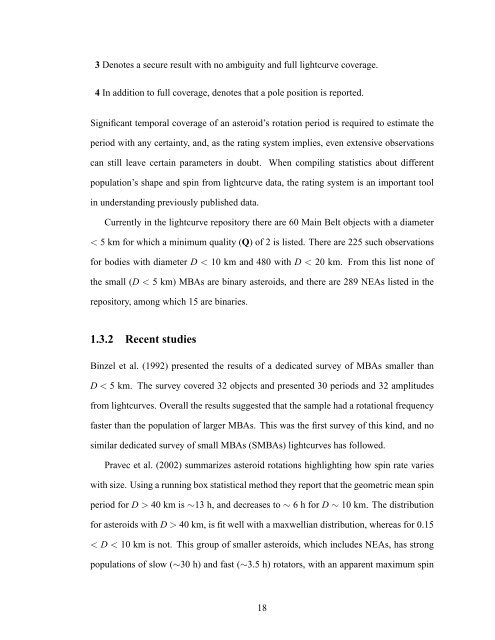Forming Binary Near-Earth Asteroids From Tidal Disruptions
Forming Binary Near-Earth Asteroids From Tidal Disruptions
Forming Binary Near-Earth Asteroids From Tidal Disruptions
You also want an ePaper? Increase the reach of your titles
YUMPU automatically turns print PDFs into web optimized ePapers that Google loves.
3 Denotes a secure result with no ambiguity and full lightcurve coverage.4 In addition to full coverage, denotes that a pole position is reported.Significant temporal coverage of an asteroid’s rotation period is required to estimate theperiod with any certainty, and, as the rating system implies, even extensive observationscan still leave certain parameters in doubt. When compiling statistics about differentpopulation’s shape and spin from lightcurve data, the rating system is an important toolin understanding previously published data.Currently in the lightcurve repository there are 60 Main Belt objects with a diameter< 5 km for which a minimum quality (Q) of 2 is listed. There are 225 such observationsfor bodies with diameter D < 10 km and 480 with D < 20 km. <strong>From</strong> this list none ofthe small (D < 5 km) MBAs are binary asteroids, and there are 289 NEAs listed in therepository, among which 15 are binaries.1.3.2 Recent studiesBinzel et al. (1992) presented the results of a dedicated survey of MBAs smaller thanD < 5 km. The survey covered 32 objects and presented 30 periods and 32 amplitudesfrom lightcurves. Overall the results suggested that the sample had a rotational frequencyfaster than the population of larger MBAs. This was the first survey of this kind, and nosimilar dedicated survey of small MBAs (SMBAs) lightcurves has followed.Pravec et al. (2002) summarizes asteroid rotations highlighting how spin rate varieswith size. Using a running box statistical method they report that the geometric mean spinperiod for D > 40 km is ∼13 h, and decreases to ∼ 6 h for D ∼ 10 km. The distributionfor asteroids with D > 40 km, is fit well with a maxwellian distribution, whereas for 0.15< D < 10 km is not. This group of smaller asteroids, which includes NEAs, has strongpopulations of slow (∼30 h) and fast (∼3.5 h) rotators, with an apparent maximum spin18












